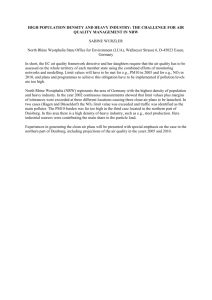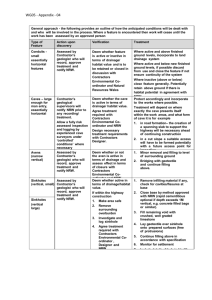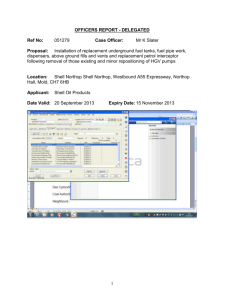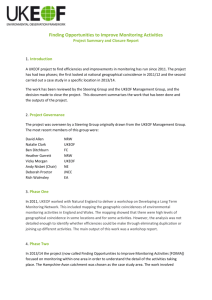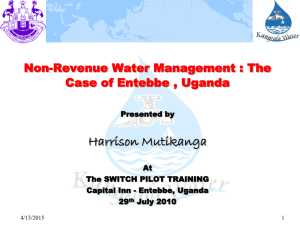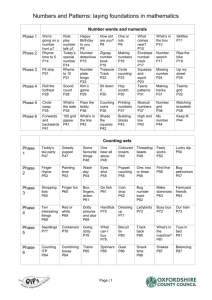Folie 1
advertisement
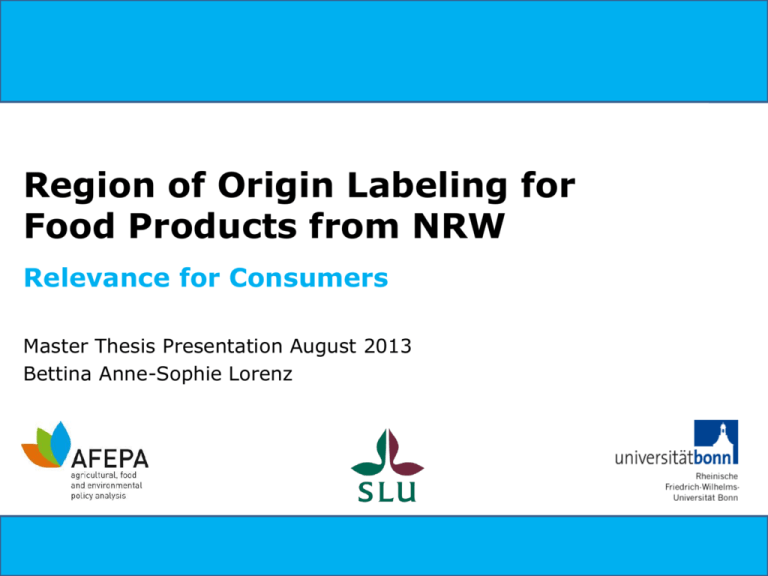
Region of Origin Labeling for Food Products from NRW Relevance for Consumers Master Thesis Presentation August 2013 Bettina Anne-Sophie Lorenz Overview 1. 2. 3. 4. 5. 6. 7. 8. 9. Motivation for Research Important Concepts Regionalmarke NRW: Status Quo of Regionality Labeling in NRW Procedure Regionality in Food Purchasing Behavior General Theory on Consumer Behavior Modelling Approach Testing the Model Results and Recommendations 8/6/2013 RoO Labelling for Food Products from NRW 2 1. Motivation for Research • Consumer Behavior as Research Area – Past studies in BA with a specialization in consumer behavior – Focus of courses at Bonn University • Regionality as Determinant of Consumer Behavior – Relevant topic in EU-CAP (Pillar II) – Topic of public interest in Germany: 65 % of consumers consider regionality at least "most of the time" (BMELV 2011) – Increased willingness to pay for regional food (von Alvensleben 1999) • Project at Bonn University: “Regionalmarke NRW” – Marketing food products produced in NRW at the scope of NRW – Until 2012 main focus on producers and expert interviews 8/6/2013 RoO Labelling for Food Products from NRW 3 2. Important Concepts 1. Concepts for Regionality • Geographical – • Cultural – – • “an area situated within one or more countries, which form an entity based on local characteristics such as traditions, culture and scenery” (van Ittersum 2002, p.3) Regional products as means to distinguish and differentiate (Besch 1999) Ethnocentrism (Frewer, Risvik and Schifferstein 2001, p.290) Communicative – – 8/6/2013 Regionality not linked to a “real” space (Wilson and Whitehead 2012) Metaphorical closeness between producers and consumers (Ermann 2002) RoO Labelling for Food Products from NRW 4 2. Important Concepts 2. Communication of Regionality for Food Products • Implicit Communication (Banik, Simons and Hartmann 2007; Hausladen 2002) – – – • Farm shops, weekly markets Direct contact between seller and consumer Restricted scope Explicit Communication (Verbeke and Roosen 2009; Ermann 2002) – – – 8/6/2013 Artificially assigned statements of origin (labels) Function similar to brands Issue of credibility when low perceived authenticity RoO Labelling for Food Products from NRW 5 3. Regionalmarke NRW: Status Quo of Regionality Labeling in NRW • Few agricultural food products with EU-regionality labels (EC 2012) • Small-scale regionality labels from producer- and processor led initatives • Regionality-based trademarks by retailers (one explicit brand for NRW) • No reliable state-based regionality label Potential for marketing agricultural food products at increased scope? • Qualitative findings: NRW is not suitable as regionality label (Banik, Simons and Hartmann 2007; Henseleit, Kubutzki and Treuber 2007) – people in NRW do identify with smaller-scale regions (cultural concept of regionality) – people in NRW hold more consistent images of sub-regions (perceived authenticity) 8/6/2013 RoO Labelling for Food Products from NRW 6 4. Procedure 1. Find out about theory on consumer behavior with respect to regionality of food products 2. Determine a model for the effect of labeled regionality in NRW on consumer food purchasing behavior 3. Conduct a quantitative survey among habitants of NRW to test the model and recommend on regionality labels in NRW (either state-based or related to sub-regions) 8/6/2013 RoO Labelling for Food Products from NRW 7 5. Regionality in Food Purchasing Behavior 1. Tripartite Model of Region-of-Origin Labeling for Food (Obermiller and Spangenberg 1989; von Alvensleben 1999) • Cognitive Elements – • Affective Elements – • based on cognitive beliefs on product characteristics (freshness, better taste, quality, safety) based on stereotypes and images (most positive image for home region and well-known holiday destinations) Normative Elements – 8/6/2013 based on perceived implications by oneself and by others (support local farmers, less traffic from short transportation) RoO Labelling for Food Products from NRW 8 6. General Theory on Consumer Behavior 2. Theory of Planned Behavior by Ajzen (1991) Attitudes Subjective Norms Behavioral Intention Behavior PBC 8/6/2013 RoO Labelling for Food Products from NRW 9 6. General Theory on Consumer Behavior 2.1. Attitudes Attitudes Subjective Norms Behavioral Intention Behavior PBC 8/6/2013 RoO Labelling for Food Products from NRW 10 6. General Theory on Consumer Behavior 2.1. • Attitudes Implicit response that supports the individual’s judgment whether something is good (positive attitude) or bad (negative attitude) (Fishbein 1967) • • Learned concept based on Expectancy Theory (Gutman 1988) Towards persons, activities, ideas Beliefs about Consequences 8/6/2013 x Relevance = RoO Labelling for Food Products from NRW Attitude towards Purchasing 11 6. General Theory on Consumer Behavior 2.2. Subjective Norms Attitudes Subjective Norms Behavioral Intention Behavior PBC 8/6/2013 RoO Labelling for Food Products from NRW 12 6. General Theory on Consumer Behavior 2.2. • • • Subjective Norms (Ajzen and Fishbein 1973) Account for social environment in which decisions take place Relate to perceived expectations of significant others Are determined by the individual’s (positive/negative) motivation to comply Beliefs about Expectations 8/6/2013 x Motivation to comply = RoO Labelling for Food Products from NRW Subjective Norms 13 6. General Theory on Consumer Behavior 2.3. Perceived Behavioral Control Attitudes Subjective Norms Behavioral Intention Behavior PBC 8/6/2013 RoO Labelling for Food Products from NRW 14 6. General Theory on Consumer Behavior 2.3. • • • Perceived Behavioral Control (Ajzen 1991) Refers to a person’s belief on his/her ability to control the behavior Product availability and self-efficacy (Armitage and Connor 2001) Based on experience and information from other persons Beliefs about Control 8/6/2013 = RoO Labelling for Food Products from NRW Subjective Norms 15 7. Modeling Approach 3. Extension to the Theory of Planned Behavior Affective and cognitive Elements of Attitudes (Breckler 1984) • in line with tripartite regionality model and the ABC model of attitudes Personal Norms (Ryan and Bonfield 1975; Schwartz and Bilsky 1987) • in line with self-concept theory: implications from others and from oneself Identification with RoO • based on ethnocentrism and cultural dimension of regionality Perceived Authenticity • based on research on regionality labeling Extension from an additive Model towards a Structural Model 8/6/2013 RoO Labelling for Food Products from NRW 16 7. Modeling Approach 4. Structural Model to determine Consumers' Purchasing Intention for Regional Food w.r.t. a specific Region and a specific Product Perceived Authenticity cognitive Attitudes affective Subjective Norms Identification with RoO Purchasing Intention Purchasing Personal Norms PBC 8/6/2013 RoO Labelling for Food Products from NRW 17 8. Testing the Model 1. Structural Equation Modeling (Fuchs 2011; Jahn 2007; Hair et al 1995) • Confirmatory method to test complex theoretical (hypothesized) models empirically • Allowing to include latent variables: unobservable variables • • Structural Model relationship between latent variables Measurement Models translating latent variables into measurable indicators feeling home feeling comfortable Friends & Family Identification with RoO Locus of Activities Integration 8/6/2013 RoO Labelling for Food Products from NRW 18 8. Testing the Model 2. Scope of quantitative Survey • Definition of an exemplary product: pork • Definition of a region: based on 12 sub regions in NRW and the current place of habitat 3. Sample and Distribution • Survey conducted among people with their current place of habitat in NRW who – are above 18 years old – do consume pork • Sample size: 1,000 respondents • Distribution: programmed online questionnaire; external market research agency 8/6/2013 RoO Labelling for Food Products from NRW 19 8. Testing the Model 4. Estimation of Parameters • Covariance-based approach (Fuchs 2011) – full information calculation of parameters of structural model and measurement models based on variance- and covariance matrices of indicators – allows for considering measurement errors in the indicators – either using Maximum Likelihood or General Least Squares for estimation of parameters • Use of software: AMOS (SPSS extension) – user friendly – widely applied program which provides extended analysis tools – data from survey will be supplied coded in SPSS by external agency 8/6/2013 RoO Labelling for Food Products from NRW 20 8. Testing the Model – Outlook 5. Evaluation of Model (Fuchs 2011; Blunch 2008; Jahn 2007) • Structural Components significance level (Type I error) α = 0.05 – parameters between latent variables >=0.2 – factor loading in measurement model >=0.7 • Measurement Model Fit – Cronbachs alpha, average variance extracted , Fornell/Larcker Criterion • Global Fit Indices – Chi-Square Test for model representing reality divide by degrees of freedom; Root Mean Squared Error of Approximation – Adjusted Goodness of Fit Index 8/6/2013 RoO Labelling for Food Products from NRW 21 9. Results and Recommendations - Outlook 1. Confirmation of theoretical Structural Model – by Significance and Value of Parameters – Global Model Fit 2. Determination of the Role of Identification and Authenticity – based on parameter values 3. Recommendation on using NRW or Sub Regions for Marketing – based on differentiation among 12 sub regions – based on additional survey questions on the notion of home (rather in NRW or in the current sub region of habitat) – based on additional survey questions on associations with sub regions in NRW compared to NRW in total 8/6/2013 RoO Labelling for Food Products from NRW 22 Literature Ajzen, I. (1991): The Theory of Planned Behavior. In Organizational Behavior and Human Decision Processes (50), pp. 179–211. Ajzen, I.; Fishbein, M. (1977): Attitude-Behavior Relations: A Theoretical Analysis and Review of Empirical Research. In Pschological Bulletin (84(5)), pp. 888–918. Alvensleben, R. von (1999): Verbraucherpräferenzen für regionale Produkte: Konsumtheoretische Grundlagen. Bonn, Nov 25th - 26th 1999. Available online at http://www.uni-kiel.de/agrarmarketing/Lehrstuhl/verbraucherregio.pdf, checked on Apr 6th 2013. Armitage, C.J; Conner, M. (2001): Efficacy of the Theory of Planned Behaviour: A meta-analytic review. In British Journal of Social Psychology (40), pp. 471–499. Banik, I.; Simons, J. Hartmann M. (2007): Regionale Herkunft als Erfolgsfaktur für die Qualitätswahrnehmung von Verbrauchern in NRW. Edited by Lehr- und Forschungsschwerpunkt „Umweltverträgliche und Standortgerechte Landwirtschaft (USL)“. Landwirtschaftliche Fakultät der Rheinischen Friedrich-Wilhelms-Universität Bonn. Bonn (Forschungsbericht, 152). Breckler, S.J (1984): Empirical Validation of Affect, Behavior, and Cognition as Distinct Components of Attitude. In Journal of Personality and Social Psychology (47(6)), pp. 1191–1205. Besch, M. (1999): Regionalisierung versus Globalisierung. In Agrarwirtschaft (48(11)), pp. 393–394. Blunch, N.J (2008): Introduction to Structural Equation Modelling using SPSS and AMOS. London: Sage Publication Ltd. BMELV (2011): Initiative biologische Vielfalt schützen und nutzen – Abschlussbericht. Available online at http://www.bmelv.de/SharedDocs/Downloads/Landwirtschaft/Klima-undUmwelt/BiologischeVielfalt/InitiativeAbschlussbericht.pdf?__blob=publicationFile, checked on Dec 16th 2012. Ermann, U. (2002): Regional Essen? Wert und Authentizität der Regionalität von Nahrungsmitteln. Edited by Bundesforschungsanstalt für Ernährung. Karlsruhe (Wissenschaftliche Jahrestagung der Arbeitsgemeinschaft Ernährungsverhalten e.V., 23). European Commission (2012): and Rural Development – DOOR registered designations. Available online at http://ec.europa.eu/agriculture/quality/door/list.html, checked on Dec 14th 2012. Frewer, L. Risvik E.; Schifferstein, H. (2001): Food, People and Society - A european Perspective if Consumers' Food Choices. Berlin: Springer-Verlag. Literature Fuchs, A. (2011): Methodische Aspekte linerarer Strukturgleichungsmodell. Ein Vergleich von kovarianz- und varianzbasierten Kausalanalysen. Research Paper. Julius-Maximilians-Universität, Würzburg. Lehrstuhl für BWL und Marketing. Hair, J.F; Anderson, R.E; Tatham, R.L; Black, W.C (1995): Multivariate Data Analysis with Readings. 4th ed. New Jersey: Prentice-Hall International Inc. Hausladen, H. (2002): Regionale Marketingkonzepte im Lebensmittelbereich - Bedeutung und Erfolgsfaktoren. Edited by Bundesforschungsanstalt für Ernährung. Freising (23. Wissenschaftliche Jahrestagung der Arbeitsgemeinschaft Ernährungsverhalten e.V.). Henseleit, M.; Kubutzki, S.; Treuber, R. (2007): Verbraucherpräferenzen für regionale Lebensmittel. In Berichte über Landwirtschaft Zeitschrift für Agrarpolitk und Landwirtschaft (85(2)), pp. 214–237. Ittersum, K. van (2002): The Role of Region of Origin in Consumer Decision-Making and Choice. Den Haag: LEI. Wilson, G.; Whitehead, I. (2012): Local rural product as a 'relic' spatial strategy in globalised rural spaces: Evidence from Country Claire (Ireland). In Journal of Rural Studies (28), pp. 199–207. Jahn, S. (2007): Strukturgleichungsmodellierung mit LISREL, AMOS und SmartPLS. Eine Einführung. Technische Universität, Chemnitz. Wirtschaftswissenschaftliche Fakultät. Obermiller, C.; Spangenberg, E. (1989): Exploring the Effects of Country-of-Origin Labels. In Advances in Consumer Research (16), pp. 454– 459. Available online at http://www.acrwebsite.org/search/view-conference-proceedings.aspx?Id=6946. Ryan, M.; Bonfield, E. (1975): The Fishbein Extended Model and Consumer Behavior. In Journal of Consumer Research (2(2)), pp. 118–136. Schwartz, S.H; Bilsky, W. (1987): Toward a Universal Psychological Structure of Human Values. In Journal of Personality and Social Psychology (53(3)), pp. 550–562. Verbeke, W.; Roosen, J. (2009): Market Differentiation Potential of Country-of-origin, Quality, and Traceability Labeling. In The Estey Centre Journal of International Law and Trade Policy (10(1)), pp. 20–35. Wilson, G.; Whitehead, I. (2012): Local rural product as a 'relic' spatial strategy in globalised rural spaces: Evidence from Country Claire (Ireland). In Journal of Rural Studies (28), pp. 199–207. Thank you very much for your Attention! Master Thesis Presentation August 2013 AFEPA Program | Bettina Anne-Sophie Lorenz
